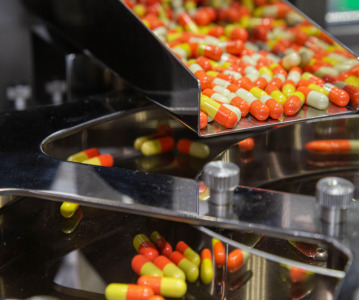CPHI Worldwide experts propose new FDA quality metrics system and recommend critical formulation attributes

Continuous processing at a ‘tipping point’, with CDMO implementation over next 3 years, but the industry needs a better definition of what ‘continuous’ means.
CPHI Worldwide has announced the findings of Part I of the 2016 CPHI Annual Report on potential new approaches to improve quality and manufacturing process in pharmaceutical production ahead of CPHI Worldwide 2016 in Barcelona. Five World-renowned experts – Ajaz Hussain, Girish Malhotra, Brian Carlin, Pabir Basu and Thomas Friedli – propose improved methods to evaluate and consider quality in the pharmaceutical industry, making a number of key recommendations.
The overall findings reveal there are a number of improvements industry and the regulators can and should make to shift the industry from just meeting standards towards instilling continuous improvement and quality cultures across the board, which the panel predict will vastly improve overall quality and reduce manufacturing errors.
Prabir Basu, independent consultant and Prof Thomas Friedli of the University of St Gallen review a new systems-based approach to quality metrics in their article – following the University receiving an FDA grant to undertake this. The goal is to recommend a measurement system based on St. Gallen’s Operational Excellence model, which encourages improved quality rather than lagging indicators that measure symptoms. The team, which also includes the Dublin Institute of Technology, state that these new metrics will "help the FDA to establish a clear standard for review and inspection, allowing for a risk-based regulatory approach, transforming quality oversight from a qualitative to a quantitative risk-based process".
Furthermore, Brian Carlin, Director of Open Innovation at FMC warns that excipient risk cannot be fully assessed during development, as product and process changes, including scale-up, have the propensity to change the risk profile. Excipient criticality may be dependent on variations and process changes that occur during manufacturing, which will be unknown at the time of filing. He added: "Continuous monitoring of impact from all excipients throughout the lifecycle is more important than a one-off arbitrary binary classification during development. The importance of all attributes and parameters should be evaluated for impact, and re-evaluated as new information becomes available."
Emphasising the panel’s concern regarding the need to shift towards quality cultures and away from binary measures of product failure, Ajaz Hussain, CEO at Insight Advice & Solutions LLC states that the “file first, figure it out later” mindset is a fundamental part of the problem. He believes that companies that implement QbD and PAT early in development will see the greatest benefits and have the capabilities to “file first”. He added: "‘Broader adoption of PAT-based continuous manufacturing system by brand and by a couple of major generic and CDMO’s should be more prominently evident in the next 3 years."
Ajaz believes the industry is now at a ‘tipping point’ with the first adopters of continuous processing having been included in NDAs, and an excellent opportunity now exists for the manufacture of injectables and we should expect more progress during the 3 three years. He argues, however, the ability to manufacture continuous, while significant, is, in fact, a business decision.
Similarly, Girish Malhotra, President at EPCOT International, suggests that although there is much excitement around continuous processing, we must better define what it is we mean by continuous – as in terms of APIs, very few products have the scale to be manufactured truly continuously. There simply aren't the volumes needed and the industry's greatest shortcoming is its overall record of manufacturing technology innovation. He commented: "When all's said and done, each company producing APIs or their formulations has to justify and use the most cost-efficient technology (batch, campaigned batch or continuous) to produce products that are economic and deliver the same quality all the time. Regulators can only regulate and assure product quality. They can suggest the technologies and methods companies should consider for their products. However, companies have to justify use of such technologies. Excellence comes from within the companies rather than outsiders.’
Chris Kilbee, Group Director Pharma at CPHI, said: “The findings in this report will be disused further at CPHI Worldwide during the CPHI annual report media debate, but it is clear that although the industry is making significant improvements to overall quality, our experts believe that continuous improvement programmes and on-going analysis are more important to instilling a quality culture than simply striving to achieve minimum regulatory standards. What’s really exciting is that over the next few years we should see a shift towards harmonised standards and more advance manufacturing. By implementing the recommendations from our panel, the pharma industry will advance more quickly, develop better and safer drugs and realise the full potential of lower cost and higher quality manufacturing.”
Related News
-
News Pharmapack Awards 2024 Patient-Centric Design Award Winner – Dr Ferrer BioPharma
The 2024 Pharmapack Awards celebrated the best in innovation and design for the pharmaceutical packaging and drug delivery industry on January 24, 2024. -
News Women in Pharma: Minding the Gap at Pharmapack 2024
2024 marks the first year Pharmapack will host a Diversity track dedicated to bridging the gap within the pharmaceutical packaging and drug delivery sector. The track includes a panel discussion on 'Enabling Diversity in the Workplace,' focused... -
News Pharmapack Awards 2024 - Celebrating Packaging and Drug Delivery Innovation
The 2024 Pharmapack Innovation Awards ceremony celebrated the best in pharmaceutical packaging and drug delivery innovation at all levels. The awards were held on January 24, 2024 at the Paris Expo Porte de Versailles. -
News Pharmapack 2024 - From the Floor
Paris once again welcomes Europe’s leading trade show in pharmaceutical packaging and drug delivery innovation. Join our content team as Pharmapack 2024 opens its doors to leading experts and innovators in pharmaceutical packaging and drug delive... -
News CPHI Barcelona 2023: Partnering for Success – Managing Outsourcing Relationships to Optimise Manufacturing Operations
During CPHI Barcelona 2023, insightful content sessions offered attendees the chance to explore trending topics with expert speakers and panellists. Here, we summarise what the pharma industry and supply chain are talking about the most. -
News CPHI Barcelona 2023: Loading Potential – Artificial Intelligence for Pharma Manufacturing
During CPHI Barcelona 2023, insightful content sessions offered attendees the chance to explore trending topics with expert speakers and panellists. Here, we summarise what the pharma industry and supply chain are talking about the most. -
News Pharmaceutical industry supports COP28 health stance in joint statement
As COP28 takes place over this week in Dubai, UAE, several bodies in the pharmaceutical and health industries have come together to announce support of key movements in sustainability in the sector, and to recognise sustainability as a health issue.&nb... -
News CPHI Podcast Series: Start-ups take centre stage at CPHI Barcelona
The first episode of the CPHI Podcast Series since we attended CPHI Barcelona in October covers the Start-up market at the event, with expert Matthew Wise joining Editor Lucy Chard to discuss the event.
Position your company at the heart of the global Pharma industry with a CPHI Online membership
-
Your products and solutions visible to thousands of visitors within the largest Pharma marketplace
-
Generate high-quality, engaged leads for your business, all year round
-
Promote your business as the industry’s thought-leader by hosting your reports, brochures and videos within your profile
-
Your company’s profile boosted at all participating CPHI events
-
An easy-to-use platform with a detailed dashboard showing your leads and performance





.png)

